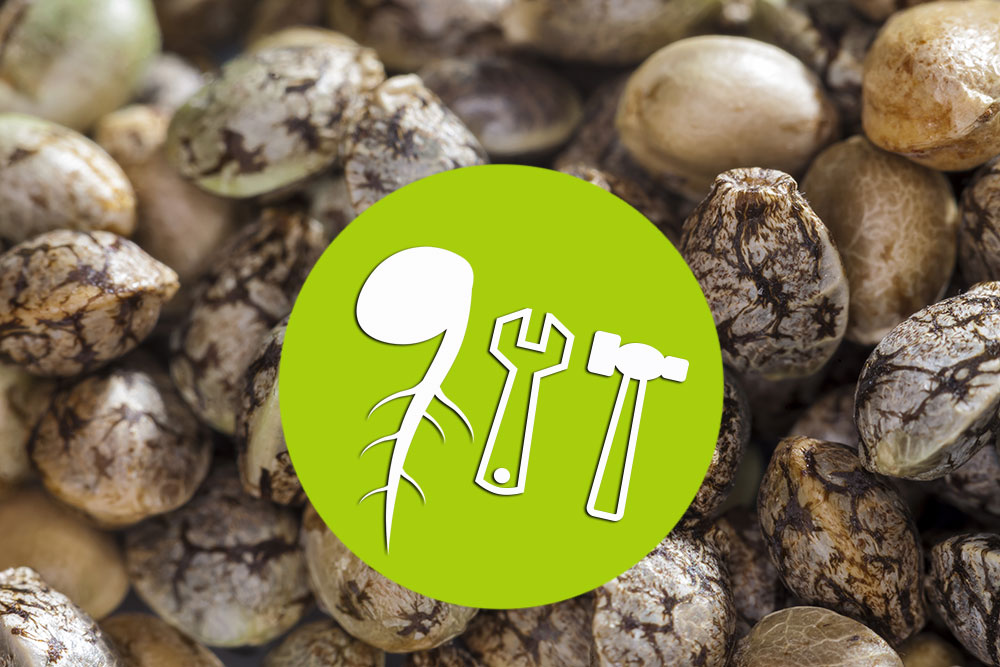Everything starts with the germination of the seeds. If something goes wrong here, a successful grow quickly becomes a distant prospect. Germinating cannabis seeds is not an art, but there are a few things that should be taken into account. In the following article, we present the most common mistakes in germination.
There are different ways to germinate cannabis seeds: between kitchen paper, in a water jar, in a greenhouse, planting directly, etc. With each option, there are bound to be things you can do wrong that can lead to major problems.
Germination on kitchen paper or cotton pads
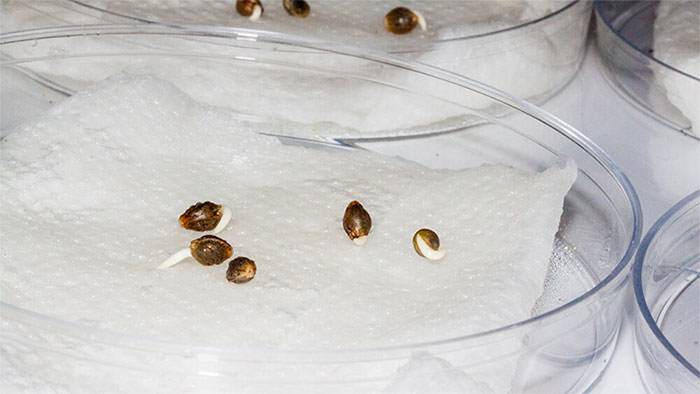
In this method, kitchen paper or cotton pads are made damp. Then the seeds are placed on the damp support and covered with kitchen paper. The whole thing is best kept in a small greenhouse or a clean container with a lid to keep the temperature and humidity constant.
What can go wrong here?
The cannabis seeds are exposed to excessive temperature fluctuations:
- If the temperature fluctuations are too great, cannabis seeds will not germinate. A temperature of 22-26°C is best for germination. The temperature should remain stable all the time.
Taproot too long
- When the seed cracks open, the small white taproot emerges. If this root grows too long, it will stick to the paper or cotton wool and can be torn off or damaged when transplanting into a substrate. The taproot grows quickly, so do not hesitate to plant the germinated seeds as soon as the small root appears.
Root in the air
- If the roots are in contact with air for too long, they can die. Roots should therefore always be covered with damp paper, cloth or substrate.
Germination with Jiffis
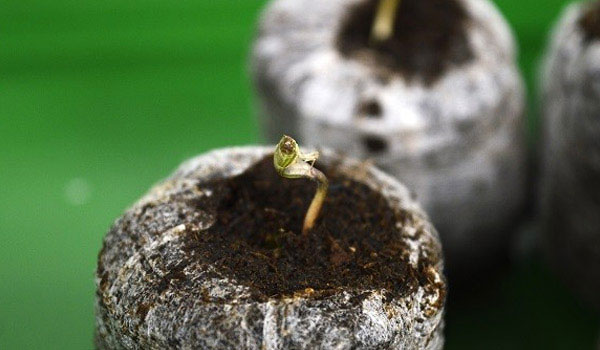
The small Jiffy discs are made of dehydrated pressed peat or coconut substrate and are surrounded by a thin net that keeps them in shape. When the Jiffy is moistened, it swells and increases its volume. After the jiffy has swelled and absorbed sufficient water, the cannabis seed is placed in the centre so that it can germinate.
What can you do wrong?
Too airtight
- Jiffies need to be protected from drying out too quickly, but if you put them in an airtight greenhouse or container, the humidity can become too high and mould or other harmful fungi can develop. If you use a greenhouse, always make sure that the air vents are open and that there is always some air exchange. Additionally, ventilate the container or greenhouse at least twice a day for several minutes by removing the lid. Young seeds in their moist substrate can quickly become mouldy or attacked by destructive bacteria if the humidity and temperature are not right.
The ideal humidity for germination is 70%. If the humidity is below this, germination will be slowed down and less successful. If it is above that, mould and harmful bacteria can occur.
Too wet
- Jiffies should be well moistened but at the same time not dripping with water. The jiffy should always remain moist during germination but never stand in water. Jiffies can easily be overwatered. The result is that the seed literally drowns. If a seed does not receive sufficient aeration, it cannot germinate.
Planted too deep
- Seed should be planted about 1 cm deep below the substrate surface. If the seed is planted too deep in the jiffy, it will be difficult for the seedling to reach the light.
Sufficient lighting should be provided right from the start of germination so that the plants can develop well from the beginning. With sufficient lighting, the jiffy can quickly dry out. This must be avoided at all costs because the seedling cannot survive a dry phase.
Excessive temperature fluctuations
- Excessive temperature fluctuations make germination impossible.
Several seeds in one Jiffy
- A Jiffy can only hold one seed at a time. There is no room for 2 seeds.
Waiting too long to plant
As soon as the seedling has the first pair of leaves, it should be placed in a pot with a good substrate. A jiffy cannot provide enough space for the roots for long.
Germination in soil
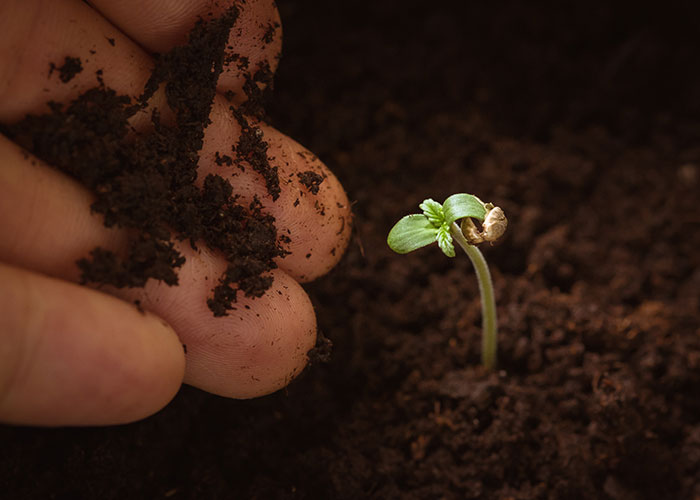
The seed can also be put directly into the soil and into the plant pot to germinate.
What can go wrong here?
Too deep in the earth
- Even with this method, the seed should not be pressed deeper than 1 cm into the soil. Seeds that are very small should be covered with very little soil.
Substrate that has been pre-fertilised too much:
- For germination, an air-permeable and rather nutrient-poor soil mixture is needed. A full and nutrient-rich substrate like the one used for flowering is not a good idea here. A small seedling cannot process the same amount of nutrients as a large plant. If overfertilisation occurs, the young plant can simply snap off, fall over and be dead.
Unsuitable soil:
- Vegetable plants need a substrate with a different composition than cannabis plants. Even the soil you find in the forest or in the open field is not suitable for cannabis seedlings.
Overwatering:
- Too much watering and waterlogging can be absolutely deadly for seedlings and young cannabis plants. So can dehydration. Make sure that excess water can drain out of the pot quickly and well and only water when necessary.
Several seeds in one pot:
- It is advisable to plant only one seed per pot. Several seeds and plants can inhibit each other's development.
Environmental conditions too severe:
If it is too hot, too cold or too humid and you plant the seeds directly outdoors, seeds may not germinate under these conditions. Outdoors, the environmental conditions are difficult to control. For seedlings, this also means a higher failure rate. You can minimise the failure rate considerably if you always grow the seedlings indoors and under control before putting them outside.
Problems with germination in water
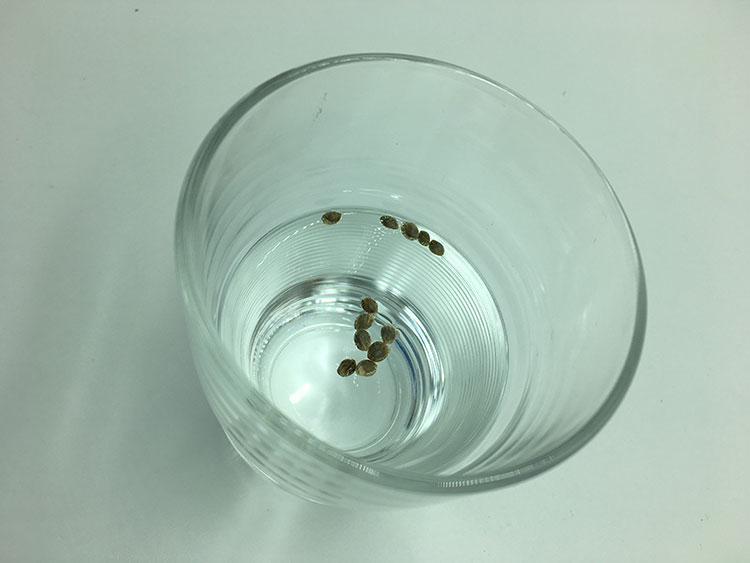
With this method, the seeds are placed directly in water for 24 hours before being placed in a small pot.
Too long in the water:
- If the seeds remain in the water too long, they can rot or "drown". As soon as the white plant root is visible, you should place the seed in a suitable substrate.
Poor water quality:
- If the water used is too hard or contaminated with harmful pathogens, the seedling may die before it has even seen the light of day. It is best to use filtered, distilled, pure water for germination.






